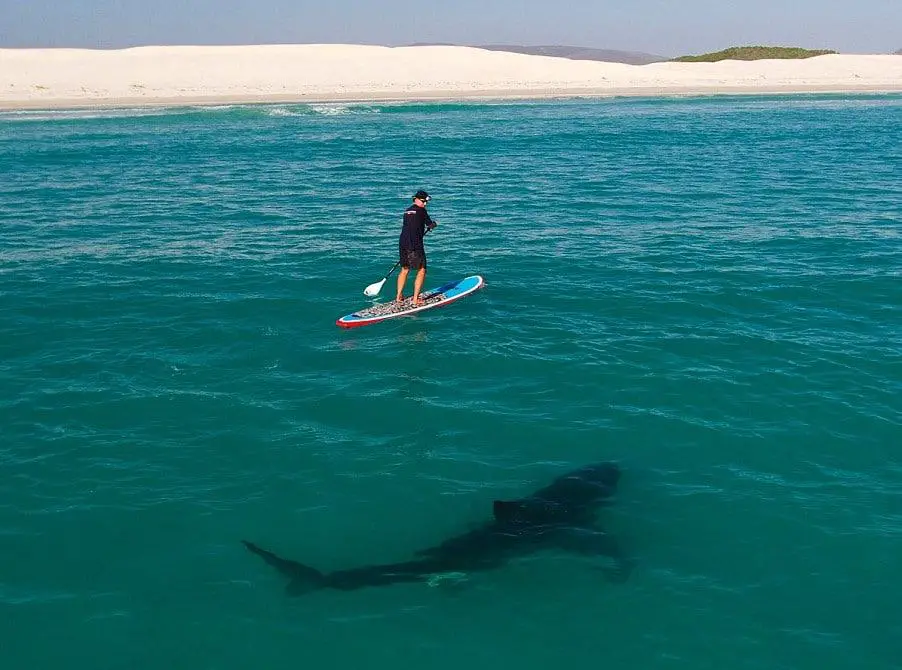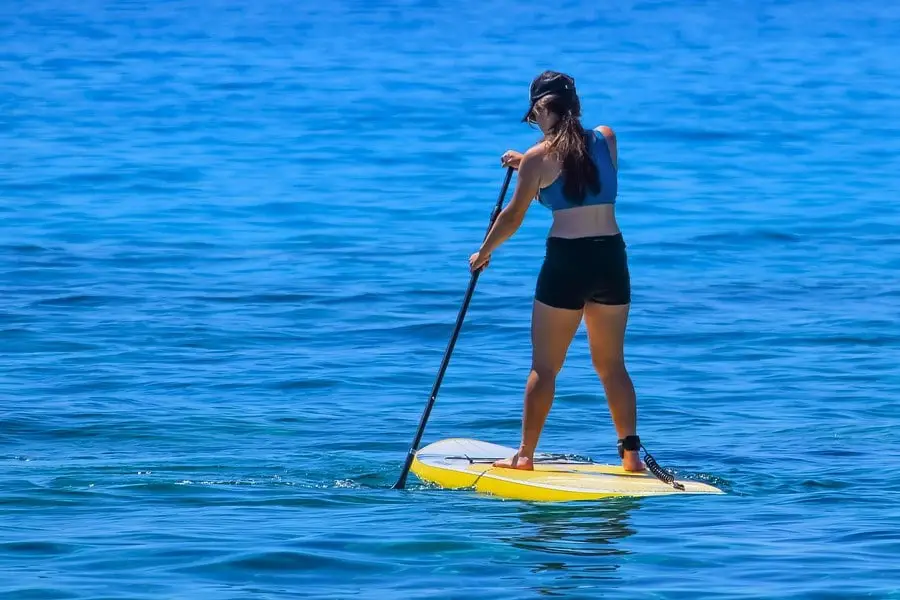How Hard is Paddleboarding?
I have good news. Paddle boarding is relatively easy to learn. Of course there are variables that will make it easier or harder.
But the truth is anyone, regardless of your age or fitness level, can learn to paddle board. You will be standing and paddling around on your first session. And because you can do so many things on a paddle board the sport will grow with your skill level.
Get started now so you can have some fun on the water. Paddle boarding is an enjoyable healthy outdoor activity you don’t want to miss.
“If you can stand up on land you can stand up paddle board”
What can make it difficult to learn SUP boarding?
- Wind
- Choppy water
- Narrow paddle board
- A paddleboard with not enough volume or float
Calm flat water is king
When you first try stand up paddleboarding make sure the water conditions are right. You want flat calm water conditions with no wind.
While most beginners understand that choppy water will be harder to balance on, they under estimate the effect of the wind.
Beginners avoid the wind
When you are standing on a paddleboard your body acts like a sail. It’s harder to keep your balance when there is wind. But even worse is that the wind will blow you around where you may not want to go.
When the wind is to your back you will find yourself moving fast and easy. You will feel like a master waterman. But when you have to turn around and paddle into the wind the fun ends. It is even hard for an experience paddler to paddle into the wind.
Never paddle out with the wind to your back
Every year hundreds of paddlers need to be rescued when the wind takes them out too far. When they turn around they don’t have the strength to paddle against the wind back into shore. This is a serious matter and has resulted in drownings. So novice paddlers should not paddle in windy conditions. And experience paddlers need to constantly monitor the wind.
Get a wide paddle board
Make sure your paddle board is wide enough and has enough float for your body weight. The wider the board the more stable it will be. 32″ is a good beginners width.
Try a Rental
Rental paddle boards are wide and stable. They have plenty of float and are great for beginners.
For a beginner bigger is better
You want enough volume or float for your weight. If you don’t have enough float the board will not feel stable. It will also be slow and hard to paddle. Again, rentals are big stable boards with plenty of volume. If you are a big person you need a paddle board with plenty of float.

Tips to Make Paddleboarding Easier
You can do it but it takes time to get good
You should be able to stand up on your very first paddle boarding session. But to get good takes time. If you have your own board get out as much as you can. While paddle boarding is not super difficult it does take some time to get comfortable on the board. To become an advanced paddler you need to get out as much as possible. The more you practice the quicker you will become a master paddler.
Stay Loose
When you first stand up on a paddle board your instincts will be to tense up to keep your balance. Instead RELAX. Keep your knees soft. Bend your knees and lower yourself when waves approach. Bending at the knees will lower your center of gravity making it easier to keep your balance.
Soft Knees
When you start think “knees soft”. You want to bend the knees slightly. Hinge foreword at the waist. But keep your head up. Keep your back straight and don’t hunch your shoulders. Look forward toward the horizon with your head up. If you look down at the board you will fall.
Head up, look forward
Your feet should be shoulder width apart. The carry handle on the deck is the most stable area of the board. Your feet should straddle or be slightly behind the board’s carry handle. Feet should be parallel facing the nose of the board.
Hold the paddle with one hand on top of the handle and the other hand wide, about half way down the shaft. This is not a broomstick. Only the bottom hand should be wrapped around the shaft.
When paddling fully submerging the paddle blade. When your paddle is in the water you have an extra balance point. Use your paddle to help keep your balance. And get the board moving. A moving paddle board is more stable than a board floating around like a cork.
Practice paddling on your knees
If you are ever in trouble squat down to your knees. Paddling on your knees is your “safe position” . Paddling on your knees is more stable than standing. It will give you time to rest. Become a master at paddling on your knees. It will also get your body out of the wind. So your body does not become a human sail blowing you around.
Dig Deeper: Beginner Paddle Boarding Technique Tips
One of the reasons paddling is so popular is that it is not super difficult.
Beginner Safety Tips
- Wear a life jacket (PFD)
- Wear an ankle leash that connects you to your board.
- Fall away from the board. Fall flat against the water and avoid falling on the paddle
- Monitor the wind
- Stay clear of other paddlers, swimmers or watercraft
Dip Deeper: Best PFDs for Paddle Boarding
Dig Deeper: Board Leash Guide
Dig Deeper: How to Avoid the Risks of Paddle Boarding
Getting back on the paddle board after you fall
For some the hardest part of paddling is not learning the balance but getting back on the board after you fall off. And chances are good you will fall when you are learning. In fact even experienced paddlers can fall from time to time. But that’s okay, this is a watersport and we are going to get wet and have some fun.
Wear a rash guard or t-shirt to protect your skin and bathing suit when you climb back on the board.
How to get back on your paddle board after you fall:
1. Look for the carry handle
2. Grab the handle with one hand
3. Grab the far rail with the other hand
4. Kick with your legs and pull the board under you
Position yourself in the middle of the board where the handle is. This is the most stable part of the board. Grab the carry handle in one hand. Use your elbows to push down on the near edge. Reach across with the other hand and grab the far rail.
Let your legs come up to the surface. In one motion kick your legs and pull the board under you. When you’re on the board stay low, make sure you’re facing the nose and get on your knees.

